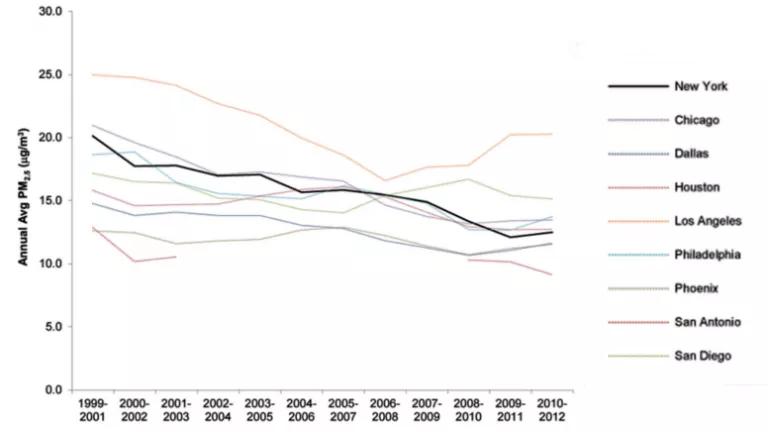Particulate Matters
New research suggests even small amounts of air pollution can make you sick.

Airborne particulate matter—from car exhaust, wildfires, coal-burning power plants, and many other sources—is terrible for your health. Studies have proven beyond doubt that inhaling these tiny particles increases the risk of heart attacks, asthma, and lung dysfunction, to name just a few disorders. The only question now is: How much particulate matter can be safely inhaled?
The answer appears to be “very little.” A massive new study, published today in the journal Environmental Health Perspectives, suggests even small amounts of particulate matter significantly threaten your well-being. Researchers at New York University-Langone Medical Center matched a health-status database of 566,000 people aged 50 to 71 with the air-pollution levels in their home states (California, Florida, Louisiana, New Jersey, North Carolina, and Pennsylvania, as well as the Detroit and Atlanta metropolitan areas). They found that an increase of 10 micrograms of PM 2.5—particles of less than 2.5 microns in diameter—per cubic meter of air raises the risk of death from heart disease by 10 percent. The risk of death from all causes rises by 3 percent. Nonsmokers, whose lungs aren’t already undermined by the effects of cigarettes, suffer the most, experiencing a 27 percent increase in the rate of death from respiratory illness.
This is a correlational study, which looks at general associations between disease and risk factors, so a caveat is in order. The researchers did not (and, realistically, could not) prove that air pollution caused or even directly contributed to any individual death. The study only shows that in places with higher levels of particulate matter, people were more likely to die from these heart or respiratory ailments. Although the authors used statistical tools to rule out other potential causes for the health problems—factors like age, ethnicity, weight, alcohol consumption, etc.—those tools are imperfect.
When you read about research that finds correlations, you should always ask two questions. First, is there a plausible mechanism for the relationship? Studies linking obesity to premature death, for example, are inherently more credible than research linking prayer to improved health outcomes, because we understand how obesity affects multiple organ systems. Second, is the study consistent with other research? A correlational study that completely upends conventional wisdom deserves extra scrutiny. Today’s study is on sound footing on both counts.
Doctors have several theories to explain why inhaling pollution would harm your heart and lungs. The tiny bits collect in the parts of the lung where gas exchange occurs, preventing oxygen from entering the bloodstream and carbon dioxide from escaping it. Especially small particulate matter can slip through the body’s filters and enter directly into the blood, where it can threaten other organs. The newly released findings also fit squarely within existing research on particulate matter and health. Hundreds of studies have shown that air pollution not only damages the heart and lungs but also increases the risk of premature birth, low birth weight, diabetes, and cancer.
This study is scary. The average PM 2.5 concentration in many U.S. cities is above 10 microgams per cubic meter. New Yorkers, Angelenos, Philadelphians, Chicagoans, and San Diegans are all inhaling too much particulate matter.
But there’s another way to look at this study: as an opportunity. The U.S. Environmental Protection Agency is now collecting data to update national particulate matter standards. If even a small increase in PM 2.5 damages health, any action we take to reduce particulate matter pollution—even modest actions—will improve our health. Every little bit counts.
This article was originally published on onEarth, which is no longer in publication. onEarth was founded in 1979 as the Amicus Journal, an independent magazine of thought and opinion on the environment. All opinions expressed are those of the authors and do not necessarily reflect the policies or positions of NRDC. This article is available for online republication by news media outlets or nonprofits under these conditions: The writer(s) must be credited with a byline; you must note prominently that the article was originally published by NRDC.org and link to the original; the article cannot be edited (beyond simple things such grammar); you can’t resell the article in any form or grant republishing rights to other outlets; you can’t republish our material wholesale or automatically—you need to select articles individually; you can’t republish the photos or graphics on our site without specific permission; you should drop us a note to let us know when you’ve used one of our articles.

The Particulars of PM 2.5
Air Pollution: Everything You Need to Know
What Is the Air Quality Index?